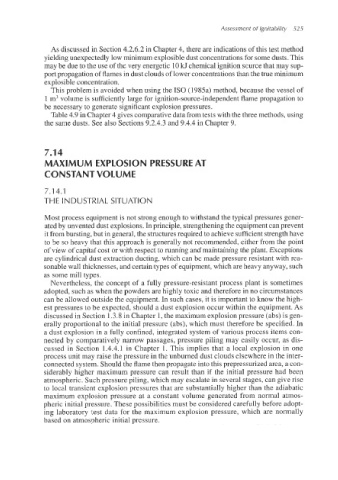Page 558 - Dust Explosions in the Process Industries
P. 558
Assessment of lgnitability 525
As discussed in Section 4.2.6.2 in Chapter 4, there are indications of this test method
yielding unexpectedly low minimum explosible dust concentrations for some dusts. This
may be due to the use of the very energetic 10kJ chemical ignition source that may sup-
port propagation of flames in dust clouds of lower concentrations than the true minimum
explosible concentration.
This problem is avoided when using the IS0 (1985a) method, because the vessel of
1 m3 volume is sufficiently large for ignition-source-independentflame propagation to
be necessary to generate significant explosion pressures.
Table 4.9 in Chapter 4 gives comparative data from tests with the three methods, using
the same dusts. See also Sections 9.2.4.3 and 9.4.4 in Chapter 9.
MAXIMUM EXPLOSION PRESSURE AT
CONSTANT VOLUME
7.14.1
THE INDUSTRIAL SITUATION
Most process equipment is not strong enough to withstand the typical pressures gener-
ated by unvented dust explosions. In principle, strengthening the equipment can prevent
it from bursting, but in general, the structures required to achieve sufficient strength have
to be so heavy that this approach is generally not recommended, either from the point
of view of capital cost or with respect to running and maintaining the plant. Exceptions
are cylindrical dust extraction ducting, which can be made pressure resistant with rea-
sonable wall thichesses, and certain types of equipment, which are heavy anyway, such
as some mill types.
Nevertheless, f:he concept of a fully pressure-resistant process plant is sometimes
adopted, such as when the powders are highly toxic and therefore in no circumstances
can be allowed outside the equipment. In such cases, it is important to know the high-
est pressures to be expected, should a dust explosion occur within the equipment. As
discussed in Section 1.3.8 in Chapter 1,the maximum explosion pressure (abs) is gen-
erally proportional to the initial pressure (abs), which must therefore be specified. In
a dust explosion in a fully confined, integrated system of various process items con-
nected bly comparatively narrow passages, pressure piling may easily occur, as dis-
cussed in Section 1.4.4.1 in Chapter 1. This implies that a local explosion in one
process unit may raise the pressure in the unburned dust clouds elsewhere in the inter-
connected system. Should the flame then propagate into this prepressurized area, a con-
siderably higher maximum pressure can result than if the initial pressure had been
atmospheric. Such pressure piling, which may escalate in several stages, can give rise
to local transient explosion pressures that are substantially higher than the adiabatic
maximum explosion pressure at a constant volume generated from normal atmos-
pheric initial pressure. These possibilities must be considered carefully before adopt-
ing laboratory test data for the maximum explosion pressure, which are normally
based on atmospheric initial pressure.

